
In his 1862 monograph (Mécanisme de la physionomie humaine. ou, Analyse électro-physiologique de l’expression des passions des arts plastiques.), French neurologist Guillaume Duchenne de Boulogne postulated that facial expressions are directly related to the soul of man. His research led to the discovery that genuine smiles, or smiles resulting from true happiness (a Duchenne smile), involve both perioral and periocular muscles. The presentation of a smile is one of the most expressive actions in which any human being can engage. A smile has been shown to initiate instinctive facial mimicry that not only expresses feelings, but also allows people to empathize and relate with one another.1 While one’s musculature is responsible for exposing the dentition through the smiling process, the presentation of the dentition plays a major role in the how other people perceive and process that relationship.2 Current cosmetic dental techniques and materials allow dentists to modify or restore the dentition to suit a patient’s wishes, and to help them put forth a self-confident smile, a Duchenne smile, that effectively broadcasts their inner feelings.
Case Study
Diagnosis
A 24-year-old female in excellent medical and good dental health presented stating she has not been to the dentist in some time and wishes to improve her oral health and the appearance of her teeth. The patient was unhappy with the shape and shade of her teeth. She was particularly concerned with the improper proportions in width-to-length ratios of her incisors and the diastema present between #8 and 9.3 (Figs. 1&2) Several areas of gingival asymmetry were also noted. The patient stated she had received orthodontic treatment in the past, and cosmetic bonding (now failed) to close the diastema between #8 and 9. She expressed her desire to have a beautiful, brighter, “natural” smile.
Fig. 1
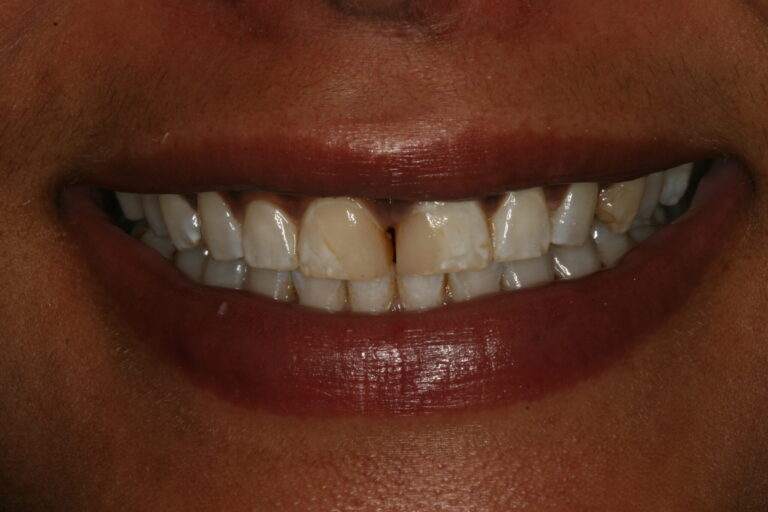
Fig. 2
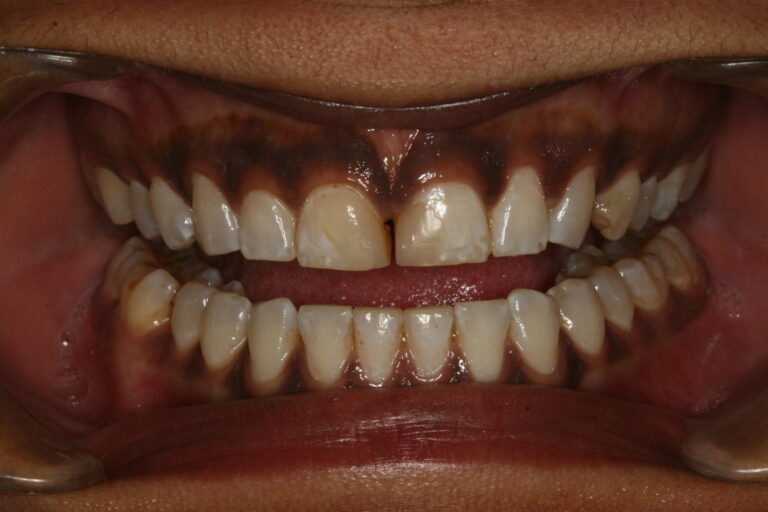
A full mouth series of periapical radiographs was made, and several failed composites and an apical abscess on tooth #3 were noted. Clinical examination revealed a Class I dental relationship with several significant occlusal interferences. Evidence of moderate wear was found on the patient’s anterior teeth, and the patient some muscular tension during a T.M.J. evaluation.4
Treatment Plan
Following discussion of esthetic restorative options for her smile, the patient elected to pursue diagnostic occlusal analysis with an anterior deprogrammer, occlusal equilibration as indicated, treatment of tooth #3 with endodontic therapy and a full coverage porcelain crown, and restoration of teeth #4, 5, 6, 7, 8, 9, 10, 11, 12, and 13 with full preparation porcelain veneers. The veneers were to be designed to esthetically enhance the dentition while restoring several failed composite resins at the same time. The patient stressed that a natural, conservative, long-lasting result was her primary goal. Proper care for the future porcelain restorations was discussed including nightly wear of a hard protective occlusal guard, and the importance of optimal maintenance including regular cleanings and examinations was stressed.5
A comprehensive set of records was made of the patient’s preoperative condition including a detailed lab prescription to allow for proper communication between the dentist and the ceramist. Honigum Pro (DMG America; Ridgefield Park, NJ) polyvinyl siloxane impressions were made of both arches, and two sets of study models were fabricated in die stone.5-8 Centric occlusion was recorded with a Futar D (Kettenbach; Eschenburg, Germany) polyvinyl siloxane bite registration and a facebow transfer. Digital photographs documenting the preoperative shade, texture, and shape of surrounding teeth were made.5,6,8,9 All records were sent to the lab where one set of models was used to fabricate a Kois deprogrammer for occlusal evaluation. The second set of study models was mounted on a semi-adjustable articulator following occlusal analysis with the Kois deprogrammer, and teeth #3, 4, 5, 6, 7, 8, 9, 10, 11, 12, and 13 were waxed to full contour. A Sil-Tech (Ivoclar Vivadent; Amherst, NY) polyvinyl siloxane stent was then formed to fabricate an incisal reduction matrix.
Description of Treatment
The Kois deprogrammer was delivered to the patient with instructions to wear it continuously for a two-week duration. Endodontic treatment of tooth #3 had been completed at a separate appointment during the time the lab was fabricating the deprogrammer. At the end of the two-week period, the patient returned to the office for functional occlusal evaluation and a second Futar D (Kettenbach; Eschenburg, Germany) polyvinyl siloxane bite registration. Several posterior occlusal interferences were noted and resolved with occlusal equilibration utilizing enameloplasty alone. The new bite record was sent to the lab to mount study models for a diagnostic waxup.
On her next visit, the patient was able to view and approve the diagnostic wax up presented on mounted study models prior to any preparation of her teeth.5,6 Under color corrected lighting, digital photographs were made from multiple angles with at least two shade tabs per photograph to assist in shade matching and color mapping (hue, chroma, and value) prior to any dehydration of the teeth.5,6 The patient again stressed her desire to have her definitive veneers be slightly lighter than her lower teeth, but to blend in with her natural dentition. This was noted for lab communication purposes.
Profound anesthesia of #3-13 was obtained by application of a topical anesthetic to areas indicated followed by injection of Lignospan Standard (Septodont; Lancaster, PA) Lidocaine HCl. 2% and Epinepherine 1:100,000. The patient’s lips were adequately retracted for the entire procedure using an Optragate lip retractor (Ivoclar Vivadent; Amherst, NY). Tissue sculpting was performed with a Gemini Diode laser (Ultradent Corp; West Jordan, UT) to even gingival levels on teeth #7, 8, and 9. Careful attention was paid in measuring tissue to be removed coupled with preoperative bone sounding to avoid invasion of biologic width. 5,6,7,8,10
Initial tooth preparation was completed with a 2000.10 Two Striper super-coarse grit diamond bur (Premier Dental; Plymouth Meeting, PA) in a high speed handpiece under copious water spray. Due to the diastema and positioning of the patient’s teeth, some subgingival tooth reduction was required to develop proper emergence profile. Adequate incisal (1.5mm) and facial (.75mm) porcelain thickness needed to provide room for layering, slight color change, and addition of incisal effects in the porcelain was confirmed with the lingual and incisal polyvinyl siloxane stent.5,6 A well defined cervical margin was established with a 703.8F diamond bur (Premier Dental; Plymouth Meeting, PA) to provide a positive veneer stop with a smooth, cleansable, precise porcelain to tooth interface while allowing for development of proper emergence profile.5,6 Photographs of the preparations were made and a preparation shade of ND2 (Ivoclar Vivadent; Amherst, NY) was recorded. (Fig. 3) Expa-syl gingival retraction paste (Acteon Group; Mèrignac, France) was expressed around all gingival margins and allowed to sit for a period of three minutes to provide hemostasis and adequate tissue reflection. After three minutes had passed, the paste was rinsed away with a copious, forceful water spray. The preparations were lightly dried and a master polyvinyl impression was made with Honigum Pro Light and Heavy impression material (DMG America; Englewood, NJ). A Futar D (Kettenbach; Eschenburg, Germany) stick bite of the prepared teeth in centric occlusion was made and photographed.
Fig. 3
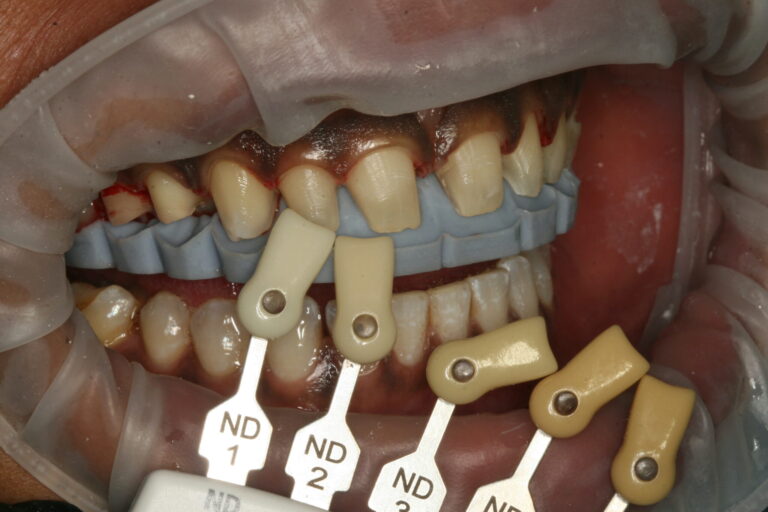
The patient’s teeth were cleaned with Consepsis chlorhexidine (Ultradent Corp; West Jordan UT). A polyvinyl siloxane stent made from the diagnostic waxup was filled with BL Luxatemp Ultra (DMG America; Ridgefield Park, NJ), placed over the prepared teeth, and allowed to cure. After approximately 1 minute, the stent was gently removed with the veneer provisionals remaining inside. The preparations were cleaned again with chlorhexidine and covered to prevent dessication. After final cure, the provisionals were removed from the stent, trimmed, and then seated with TempoCem ID (DMG America; Ridgefield Park, NJ). The temporary cement was tack cured for 5 seconds on each tooth with the Bluephase LED curing light (Ivoclar Vivadent; Amherst, NY). Excess material was removed with a #12 scalpel blade, an additional 15 second curing time per tooth was completed, and the provisionals were smoothed and finished with abrasive discs (Cosmedent Inc.; Chicago, IL) and a rubber cup polisher (Cosmedent Inc.; Chicago, IL). Occlusion was verified and checked, and the patient was appointed for a post-operative check twenty-four hours later.
The 24-hour post-operative check appointment was particularly important because it allowed the patient to express feedback based on self-analysis of the proposed shapes and contours of her new smile. The patient reviewed and approved the shape of her provisional restorations and the shade tabs selected at the prior appointment. Proper phonetics, occlusion, and anterior guidance were confirmed. A few minor adjustments to her occlusion on the lingual aspect of the provisionals were required. Photographs of the approved provisional restorations and shade tabs were made. (Figs. 4,5,&6) Other provisional records were made including a Futar D stick bite (Kettenbach; Eschenburg, Germany) in centric occlusion and a Honigum Pro polyvinyl impression (DMG America; Ridgefield Park, NJ) of the approved provisionals. (Fig 7) All records were disinfected and sent to the ceramist accompanied by a completed laboratory prescription, notes, and all photographs taken to this point. The ceramist was instructed to use the impression of the approved provisionals as a guide for the final shape, size, and contour of the porcelain restorations.
Fig. 4

Fig. 5

Fig. 6
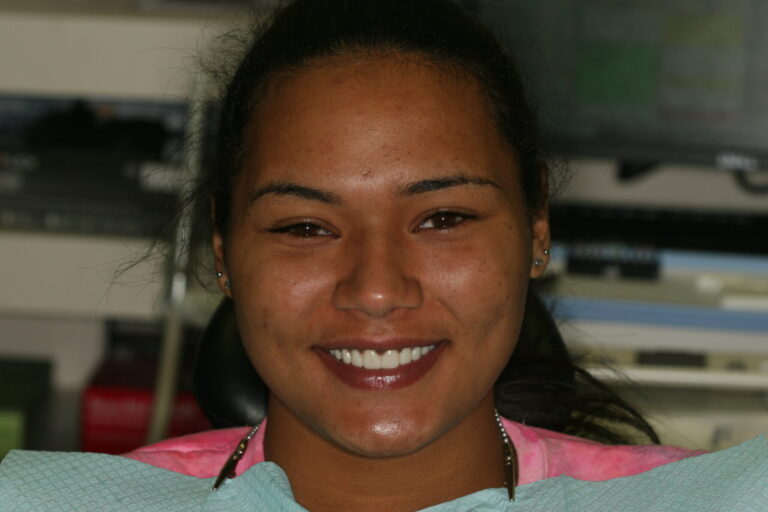
Fig. 7

Laboratory Phase
During the provisional phase the patient was able to further reevaluate the provisional restorations. If she had requested any changes, they could have been communicated to the ceramist during this period. No changes were requested during this time.
On the ceramist’s receipt of the case, the records were reviewed and the material choice on the prescription was confirmed during a telephone conversation. Shape, shade, and characterization were discussed again and finalized in the planning stage. Producing the patient’s desired shade choice dictated lithium disilicat AmberPress MO3 (Hassbio America; Fairfax, VA) to be pressed as a base shade. Cutback and layering of the pressed veneers was planned to develop restorations with the requested moderate incisal character and natural gingival staining with a lightly textured, polished gloss finish.
The full contour pressed veneers were then tried on the physical die models to confirm marginal accuracy. Cutback of each full contour milled unit was performed as needed to allow for hand layering of porcelain to develop realistic translucency, depth, and character. Following layering and firing, each unit was hand finished and polished. The ceramist meticulously confirmed fit and esthetics for the entire case. The intaglio of each unit was lightly sandblasted and then acid etched for 1 minute with 9.5% HCl (Keystone Industries; Gibbstown, NJ). The veneers were then steam cleaned and carefully packaged for return to the dentist ready for the seat appointment.
Cementation
On return from the ceramist, the porcelain restorations were re-inspected on the dies for marginal fit and on solid models for proper interproximal contacts. Profound anesthesia was obtained through the use of Lignospan Standard (Septodont; Lancaster, PA) Lidocaine HCl. 2% and Epinepherine 1:100,000 during the seat appointment. An Optragate lip retractor (Ivoclar Vivadent; Amherst, NY) was placed to assist in isolation. The provisional veneers were removed, and the preparations were cleaned to remove any residual resin temporary material or debris. The veneers were then tried into the patient’s mouth and evaluated for fit and esthetics (first individually, then collectively). The patient was then allowed to view and approve the esthetics of her smile in a hand mirror.
The approved veneers were removed from the patient’s mouth and carefully cleaned with Ivoclean cleaning paste (Ivoclar Vivadent; Amherst, NY) to remove any possible contamination. They were rinsed, dried, and Monobond silane coupling agent (Ivoclar Vivadent; Amherst, NY) was applied to the intaglio of the veneers.11 Following one minute they were air dried, and a thin coating of All Bond Universal bonding agent (Bisco; Schaumberg, IL) was applied to the inside of the veneers and air thinned. Vitique Clear Veneer Cement (DMG America; Ridgefield Park, NJ) was then applied to the veneers and they were immediately placed into a ResinKeeper light-safe box (Cosmedent Inc.; Chicago, IL) to prevent polymerization of the resin.5,6
The preparations were acid etched for 15 seconds with 32% Uni-Etch phosphoric acid gel etchant (Bisco; Schaumberg, IL) followed by rinsing with a copious air and water spray.5,6 All preparations were lightly dried, but not dessicated.5,6 Two coats of All Bond Universal bonding agent (Bisco; Schaumberg, IL) were applied to each preparation and agitated for 20 seconds prior to air thinning to evaporate solvents. Following air thinning, each tooth was cured for 20 seconds with a Bluephase LED curing light (Ivoclar Vivadent; Amherst, NY). The veneers were then removed from the light-safe box and seated on their respective preparations. Excess cement was removed with a Regular Microbrush (Microbrush International; Grafton, WI) and they were tacked into place for 5 seconds each with the curing light.12 Additional excess was removed gently with a scaler, floss was passed through the contacts in the apical direction only, and the veneers were then cured fully for an additional 30 seconds each.12 The margins were then inspected and any excess cured cement was removed with a #12 scalpel blade.12 Interproximal areas were cleaned with Epitex finishing strips (GC America; Alsip, IL). DeOx oxygen inhibiting gel (Ultradent Corp; West Jordan, UT) was expressed around all margins and the restorations were cured an additional 10 seconds to finalize polymerization.5,6,11 The lingual aspect was then polished with diamond paste and Flexibuff polishers (Cosmedent Inc.; Chicago, IL) in a slow speed handpiece and isolation was removed.
The patient’s occlusion was checked, and smooth, proper contacts were verified with dental floss. Post-operative home care instructions were given and the patient was scheduled for a follow-up appointment for radiographic and photographic documentation as well as a follow-up check for function and esthetic evaluation.
The patient returned the following day. Her functional occlusion was evaluated, and her teeth were inspected for any residual cement. Post-operative radiographs were made to confirm positive seat of margins and the absence of any residual interproximal cement. Maxillary and mandibular alginate impressions were made along with a polyvinyl siloxane bite registration for fabrication of a maxillary full arch bite guard for nighttime wear.5 Post-operative home care instructions were given and the patient was scheduled for a follow-up appointment for additional photographic documentation, a final check for function and esthetic evaluation, and delivery of the patient’s maxillary protective bite guard.5 (Figs. 8&9)
Fig. 8
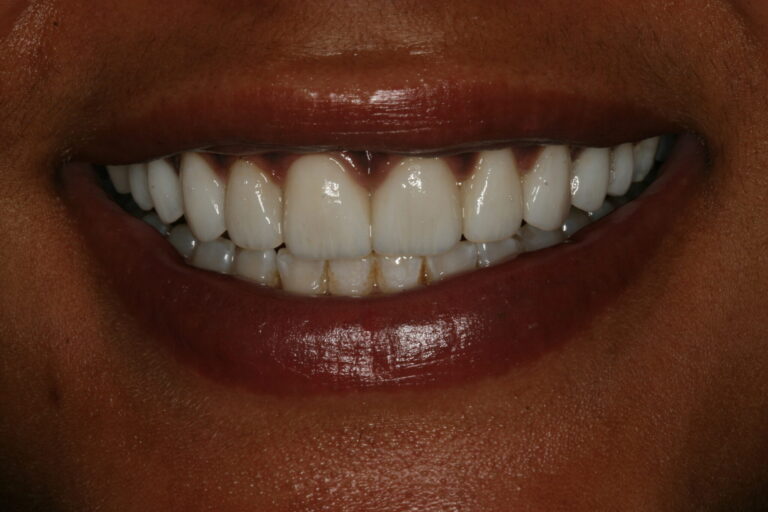
Fig. 9

Conclusion
Porcelain veneers can be employed to provide beautiful, natural, and long-lasting functional cosmetic results. While the procedure, materials, and skill involved are highly technical and quite meticulous, the result achieved often evokes a very emotional response. It is difficult to look at a genuine smile, and not feel the emotion in the picture. Scientifically, a Duchenne smile can initiate facial mimicry, but emotionally it certainly can be a window to the soul. (Figs. 10&11)
Fig. 10

Fig. 11

Oral Health welcomes this original article.
Acknowledgements: The author would like to express sincere appreciation to Wayne B. Payne, MDT, AAACD and Tyler Payne for their technical expertise and beautiful porcelain work.
References
- Wood et al. Fashioning the Face: Sensorimotor Simulation Contributes to Facial Expression Recognition. Trends in Cognitive Sciences, 2016.
- Beall, A. E.. Can a new smile make you look more intelligent and successful? Dental Clinics of North America, 51(2), 289-297, 2007.
- American Academy of Cosmetic Dentistry. Diagnosis and Treatment Evaluation in Cosmetic Dentistry: A Guide to Accreditation Criteria. Madison (WI): The Academy; 2001.
- Dawson, Peter E. Evaluation, Diagnosis, and Treatment of Occlusal Problems. The C.V. Mosby Co.: St Louis, MO; 1989.
- Magne, Pascal. Bonded Porcelain Restorations in the Anterior Dentition A Biomimetic Approach. Quintessence Books: Chicago, IL; 2002.
- Gurel, Galip. The Science and Art of Porcelain Laminate Veneers. Quintessence Books: Chicago, IL; 2003.
- Rufenacht CR. Fundamentals of Esthetics. Quintessence Books: Chicago, IL; 1992.
- Fradeani, Mauro. Esthetic Analysis A Systematic Approach to Prosthetic Treatment Volume 1. Quintessence Books: Chicago, IL; 2004.
- Goldstein, Ronald E. Esthetics In Dentistry. B.C. Decker, Inc.: Hamilton, Ontario; 1998.
- Flax, Hugh. Smile Enhancement With Laser Technology- Predictable and Esthetic: A Case Report. The Journal of Cosmetic Dentistry. 23(1): 92-98, 2007.
- Touati B, Quintas AF. Aesthetic and Adhesive Cementation for Contemporary Porcelain Crowns. Practical Procedures in Aesthetic Dentistry. 13(8): 611-620, 2001.
- Miller, Michael B. Reality: The Techniques: Volume I. Reality Publishing Co.: Houston, TX; 2003.
About the Author

W. Johnston Rowe maintains a private practice dedicated to excellence in general, cosmetic, and complex restorative dentistry located in Jonesboro, Arkansas. He has been awarded Fellowships in the International College of Dentists and the Pierre Fauchard Academy. He is a graduate of the University of Tennessee College of Dentistry, and is a formally trained artist having graduated from Washington and Lee University with a Bachelor of Arts degree in Studio Art. Dr. Rowe enjoys sharing his passion for cosmetic dentistry materials and techniques, lecturing nationally and internationally, and can be contacted through his office at info@rowesmiles.com or 870.932.4126.









